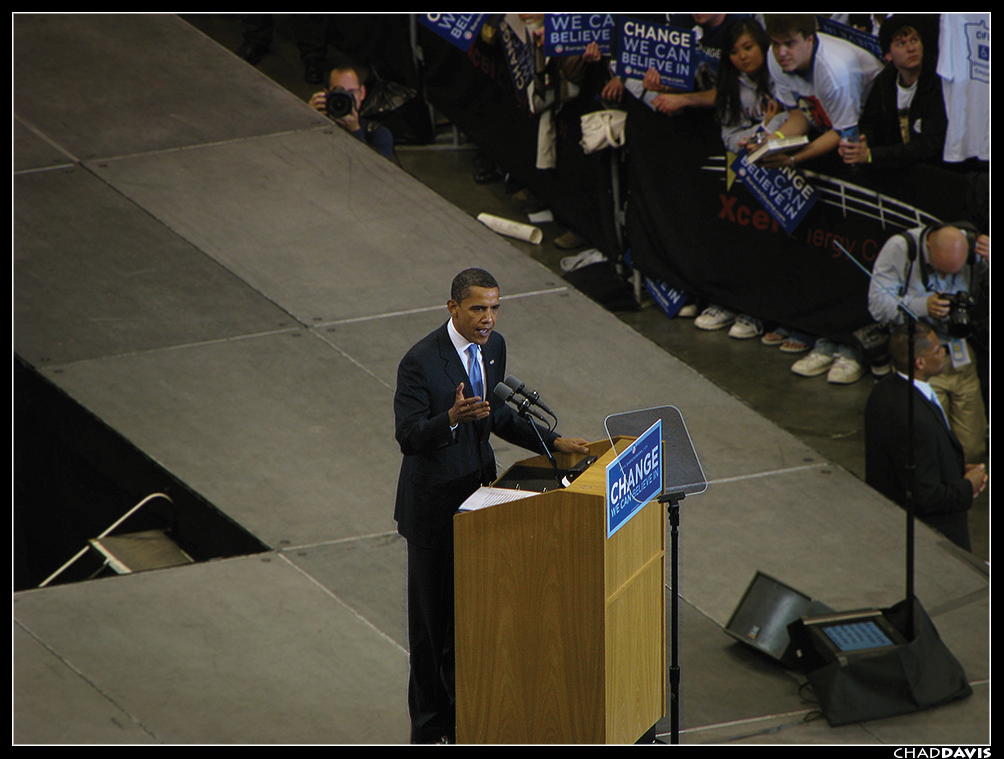18.6: Delivery Methods and Practice Sessions
Learning Objectives
Making informed decisions about delivery can boost your confidence and manage speaking anxiety. In this section, we will learn some strengths and weaknesses of various delivery methods and how to make the most of your practice sessions.
Delivery Methods
While it may be acceptable to speak from memory in some situations, lengthy notes may be required in others. The four most common delivery methods are impromptu, manuscript, memorized, and extemporaneous.
Impromptu Delivery
When using impromptu delivery, a speaker has little to no time to prepare for a speech. This means there is little time for research, audience analysis, organizing, and practice. For this reason, impromptu speaking often evokes higher degrees of speaking anxiety than other delivery types. Although impromptu speaking arouses anxiety, it is also a good way to build public speaking skills. Using some of the exercises for managing speaking anxiety that were discussed earlier in this chapter can help a speaker better manage the challenges of impromptu speaking. Only skilled public speakers with much experience are usually able to “pull off” an impromptu delivery without looking unprepared. Otherwise, a speaker who is very familiar with the subject matter can sometimes be a competent impromptu speaker (expertise can compensate for the lack of research and organizing time).
When speaking impromptu, be brief, stick to what you know, and avoid rambling. Quickly organize your thoughts into an introduction, body, and conclusion. Try to determine three key ideas that will serve as the basis of your main points.
Most of our day-to-day interactions involve impromptu speaking, but in what situations would impromptu speaking be required at work? If you participate in a meeting as the representative of the public relations department, a colleague may ask you to say a few words about a recent news story involving a public relations misstep of a competing company. In this case, you are expected to speak on the spot because of your expertise. A competent communicator should anticipate instances like this and be prepared. If, at any point, you are asked to comment on something entirely unfamiliar to you, do not pretend to know something you don’t, as that may come back to hurt you later. You can usually mention that you do not have the necessary background information at that time but will follow up later with your comments.
Salespeople are generally good at impromptu speaking. They obviously have sales training and have built up a repertoire of adjectives and sayings that entice audiences to buy. Their ability to remain animated and fluent in their delivery with little time to prepare comes from much experience. Politicians, lawyers, teachers, journalists, and spokespeople also regularly engage in impromptu speaking.
Strengths of Impromptu Delivery
- Content and delivery are spontaneous, which can make the speech more engaging (if a speaker’s anxiety is under control).
- It enhances public speaking skills because speakers have to “think on their feet.”
Weaknesses of Impromptu Delivery
- It is typically the most anxiety-inducing delivery method, since speakers do not have time to prepare or practice the speech.
- Speakers may get off topic or ramble if they did not set up some structure to guide them.
- Speakers may be tempted to overstate or mislead an audience about the extent of their knowledge or expertise if asked to speak about something they aren’t familiar with.
Manuscript Delivery
Speaking from a written or printed document that contains the entirety of a speech/ presentation is known as manuscript delivery. Manuscript delivery can be the best choice when a speech/ presentation has complicated information and/or the contents are going to be quoted or published. Despite the fact that most novice speakers are not going to find themselves in that situation, many are drawn to this delivery method because of the security they feel with having everything they are going to say in front of them. Unfortunately, the security of having every word you want to say at your disposal translates to a poorly delivered and unengaging speech/ presentation. Even with every word written out, speakers can still have fluency hiccups and verbal fillers as they lose their place in the manuscript or get tripped up over their words. The alternative, of course, is that a speaker reads the manuscript the whole time, effectively cutting himself or herself off from the audience. One way to make a manuscript delivery more engaging is through the use of a teleprompter. Almost all politicians who give televised addresses use teleprompters (see Figure 18.6.1 “President Obama’s Teleprompter System”).
Figure 18.6.1 President Obama’s Teleprompter System

You may not even notice the presence of teleprompters, as the technology has improved to give the illusion that a speaker is engaged with the audience and delivering a speech from memory. The Plexiglas sheets on poles that surround the president during the inauguration and State of the Union addresses are cleverly hidden teleprompters. Even these useful devices can fail. A quick search for “teleprompter fail” on YouTube will yield many examples of politicians and newscasters who probably wish they had a paper backup of their speech. Since most of us will likely not have opportunities to speak using a teleprompter, great care should be taken to ensure that the delivery is effective. To make the delivery seem more natural, print the speech out in a larger-than-typical font, triple-space between lines so you can easily find your place, use heavier-than-normal paper so it’s easy to pick up and turn the pages as needed, and use a portfolio so you can carry the manuscript securely. (This is recommended for, say, conference presentations, if you have to speak for 20 minutes or more — not for short presentations in college or at work.)
Strengths of Manuscript Delivery
- The speaker can include precise or complex information such as statistics or quotes.
- The entire content of the speech is available for reference during the delivery.
- The speech will be consistent in terms of content and time length, which is beneficial if a speech will be delivered multiple times.
Weaknesses of Manuscript Delivery
- Engagement with the audience is challenging, because the speaker must constantly reference the manuscript (unless a teleprompter is used).
- Speakers are unable to adapt information to audience reactions, since they are confined to the content of the manuscript.
- Speakers may be tempted to read the entire time because they didn’t practice enough or because they get nervous.
- Speakers who are able to make eye contact with the audience may still sound like they are reading rather than presenting — unless they employ proper vocal variety, pacing, and pauses.
Memorized Delivery
Completely memorizing a speech and delivering it without notes is known as memorized delivery. Some students attempt to memorize their speech because they think it will make them feel more confident to not have to look at their notes; however, when their anxiety level spikes at the beginning of their speech and their mind goes blank for a minute, many admit they should have chosen a different delivery method. When using any of the other delivery methods, speakers still need to rely on their memory. An impromptu speaker must recall facts or experiences related to their topic, and speakers using a manuscript have some of their content memorized so they do not read their entire time and miss the opportunity for eye contact. The problem with memorized delivery overall is that it puts too much responsibility on our memory, which we all know from experience is fallible.

When memorizing, most people use rote memorization techniques, which entail reading and then reciting something over and over until it is committed to memory. One major downfall of this technique is its effect on speaking rate. When we memorize this way, we end up going over the early parts of a speech many more times than the later parts. As you memorize one sentence, you add on another, and so on. By the time you’re adding on later parts of your speech, you are likely speed talking through the earlier parts because you know them by heart. To prevent bad habits from practice from hurting our delivery, we should practice speeches/ presentations the exact way we want to deliver them to our audience. Fast-paced speaking during practice will likely make its way into the actual delivery. Delivery also suffers when speaking from memory if the speaker sounds like he/she is flatly “reciting.” Rote memorization tasks that many of us had to do in school have left their mark on our memorized delivery.
Memorized delivery may be a good idea only if the speech/presentation is short (only one to two minutes), is personal (like a brief toast), or will be repeated numerous times (like a tour guide’s spiel) — and even in these cases, it may be perfectly fine to have notes. Many students think that their anxiety and/or delivery challenges will be fixed if they just memorize their speech only to find that they are more anxious and have more problems.
Strengths of Memorized Delivery
- Speakers can include precise or complex information such as statistics or quotes (if they have put the time into memorization).
- Speakers can directly engage with the audience without worrying about referencing notes.
- The speech will be consistent in terms of content and time-length, which is beneficial if a speech will be delivered multiple times.
Weaknesses of Memorized Delivery
- It is the most time-consuming in terms of preparation.
- Speakers are unable to adapt information to audience reactions, since they are confined to the content they memorized.
- If speakers lose their place in the speech, they will likely have to start over.
- Since everything is preplanned, it is difficult to make the speech content and delivery seem genuine (i.e., humor may seem “canned” or corny).
- The speech can sound like a recitation if the proper vocal variety and pacing are not used.
Extemporaneous Delivery
Extemporaneous delivery entails memorizing the overall structure and main points of a speech/presentation and then speaking from keyword/key-phrase notes. This delivery mode brings together many of the strengths of the previous three methods. Since you internalize and memorize only the main structure, you don’t have to worry as much about the content and delivery seeming stale. Extemporaneous delivery brings in some of the spontaneity of impromptu delivery but still allows a speaker to carefully plan the overall structure and incorporate supporting materials that include key facts, quotations, and paraphrased information. You can also more freely adapt your speech/presentation to fit various audiences and occasions, since every word and sentence isn’t predetermined. This can be especially beneficial when a speech/presentation will be delivered multiple times. Your professors’ lectures are good examples of extemporaneous delivery. Even though they may have presented the basic content of each lesson dozens of times over the years, each presentation has been different, because they vary the examples and amount of elaboration added to the (memorized) core content. For instance, while COMM 6019 is offered in most graduate certificates at Fanshawe, professors teaching two or more sections in different programs would likely change the examples they use to illustrate certain points, so they can make the content more relevant for specific groups. They might also change the examples they use from one semester to the next, based on relevant local and global events and news coverage.
When preparing a speech/ presentation that you will deliver extemporaneously, start practicing early and then continue to practice as you revise your content. Investing quality time and effort into the outlining process helps with extemporaneous delivery. As you put together your outline, you are already doing the work of internalizing the key structure of your speech. Read parts of your outline aloud as you draft them to help ensure they are written in a way that makes sense and is easy for you to deliver. By the time you complete the formal, full-sentence outline, you should have already internalized much of the key information in your speech. Now, you can begin practicing with the full outline. As you become more comfortable with the content of your full outline, start to convert it into your speaking outline. Take out information that you know well and replace it with a keyword or key phrase that prompts your memory. Leave key quotes, facts, and other paraphrased information, including your verbal source citation information, on your delivery outline so you make sure to include it in your delivery. Once you’ve converted your full outline into your speaking outline, practice it a few more times, making sure to take some time between each practice session so you don’t inadvertently start to memorize everything word for word. The final product should be a confident delivery of a well-organized and structured speech/presentation that is conversational and adaptable to various audiences and occasions.
Strengths of Extemporaneous Delivery
- Speech content and delivery appear more spontaneous and natural, making it more conversational, since the speaker is using a keyword/key-phrase outline.
- Speakers can include quotes or complex information on their speaking outline for easy reference.
- Speakers can adapt information and delivery to specific audiences, occasions, and audience reactions, since they are not confined to the content of a manuscript or what they memorized.
Weaknesses of Extemporaneous Delivery
- Since the speech is so adaptable, it can be difficult to ensure the speech will be the exact same length each time.
- It is perhaps not the best option when exact wording is expected.
- Speakers must find a balance between having too much content on their speaking outline, which may cause them to read, and too little content, which may lead to fluency hiccups.
Practicing Your Speech
There are three primary phases to the practice process. In the first phase, you practice as you’re working through your ideas and drafting your outline. In the second, you practice for someone and get feedback. In the third, you put the finishing touches on the delivery.
Start practicing early, as you are working through your ideas, by reading sections aloud as you draft them into your working outline. This will help ensure your speech is fluent and sounds good for the audience. Start to envision the audience while you practice and continue to think about them throughout the practicing process. This will minimize anxiety when you actually have them sitting in front of you. Once you have completed your research and finished a draft of your outline, you will have already practiced your speech/ presentation several times as you were putting it together. Now, you can get feedback on the speech/presentation as a whole.

Ask for feedback from a trusted source in the second phase of practicing your speech/ presentation. This will lower your anxiety concerning the moment when you will have to speak in front of a full audience. Choose someone who will give you constructive feedback, not just unconditional praise or criticism. Before you practice for this trusted person, explain the assignment or purpose of the speech/ presentation. Ask for feedback on content and delivery. (Almost anyone is good at evaluating delivery.) Also begin to time your speech/ presentation at this point, so you can determine if it meets any time limits that you have.
You may also want to audio or video record one of your practice sessions. This can be useful because it provides an objective record that you can then compare with the feedback you got from your friend or colleague and to your own evaluation of your delivery.
Most importantly, incorporate the feedback you receive into your speech. Use the feedback to assess whether or not you met your speaking goals. Was your thesis supported? Was your specific purpose met? Did you stay within the time limits set? Based on your answers to these questions, you may need to make some changes to your content or delivery, before you move on to the next phase of practice.
During the third and final phase of practice, you are putting the finishing touches on your speech/presentation. Your practice sessions at this point should create, as much as possible, the conditions in which you will be giving your speech/presentation. You should have your speaking outline completed so you can practice with it. It’s important to be familiar with the content on your note cards or speaking outline so you will not need to rely on it so much during the actual delivery. You may also want to practice in the type of clothing you will be wearing on speech day. This can be useful if you are wearing something you don’t typically wear—a suit, for example—so you can see how it might affect your posture, gestures, and overall comfort level. If possible,do at least one practice session in the place you will be giving the speech/presentation, especially if it is a room you are not familiar with. Practice with any visual aids or technology you will use so you can be familiar with it and so it does not affect your speech fluency. Continue to time each practice round. If you are too short or too long, you will need to go back and adjust your content some more. Always adjust your content to fit the time limit; do not try to adjust your delivery. Trying to speed talk or stretch things out to make a speech shorter or longer is a mistake that will ultimately hurt your delivery, which will hurt your credibility. The overall purpose of this phase of practicing is to minimize surprises that might throw you off during your delivery in front of your audience.
![]() Some “Dos” and “Don’ts” for Effective Speech Practice Sessions
Some “Dos” and “Don’ts” for Effective Speech Practice Sessions
- Start practicing sections of your speech early, as you draft your outline.
- Practice for someone for feedback.
- Time yourself once a draft of the speech is completed and adjust the speech as needed to conform to time limits.
- Deliver the speech the way you want it to be when you deliver it for your audience (use the rate, volume, vocal variety, pauses, and emphasis you plan to use on speech day).
- Don’t practice only in front of a mirror (practicing once in front of a mirror can help you gauge your facial expressions and other aspects of delivery, but that shouldn’t be the only way you practice).
- Don’t practice only in your head (we have a tendency to go too fast when we practice in our head, and you need to get practice saying the words of your speech to help lessen fluency hiccups).
- Don’t practice too much. It’s best to practice a few times in the days leading up to the speech/presentation date, making sure to leave several hours between practice sessions. Practicing too much can lead you to become bored with your content, which could lead to delivery that sounds like a recitation.
Key Takeaways
 The four methods of delivering a speech are impromptu, manuscript, memorized, and extemporaneous delivery.
The four methods of delivering a speech are impromptu, manuscript, memorized, and extemporaneous delivery.- Impromptu delivery evokes higher levels of speaking anxiety because a speaker has little to no time to prepare the speech/ presentation; however, this method can increase public speaking skills for people who enjoy thinking on their feet.
- Manuscript delivery entails speaking from a manuscript that contains a word-for-word transcript of your speech/presentation. This delivery method can be good for speeches/presentations that contain complex information that will be published or quoted but can be challenging because speakers may read all the time, which lessens engagement with the audience.
- Memorized delivery entails speaking from memory. Speakers with a reliable memory will be able to include specific information and engage the audience freely. This method is the most time-consuming option in terms of preparation, and the delivery may come across as a recitation instead of being engaging.
- Extemporaneous delivery entails memorizing the general structure of a speech/ presentation, not every word, and then delivering the speech from a keyword outline. Having the keyword outline allows a speaker to include specific information and references while remaining adaptable to the occasion and audience since every word isn’t planned out.
- Practicing your speech/ presentation should occur in three phases. First, practice as you are drafting the outline to help you process through your main ideas. Second, practice for someone and get feedback, and perhaps record your speech/presentation for self-evaluation. Use this feedback to make appropriate changes to your speech. Third, put the finishing touches on the speech/presentation: make needed adjustments to the content to meet time limits, become familiar with your speaking outline, and create the conditions of your speech/presentation day for your final few practice sessions.
Exercises
 Which delivery methods have you used before? Which did you like the best and why? Which delivery method would you most prefer a speaker to use if you were an audience member and why?
Which delivery methods have you used before? Which did you like the best and why? Which delivery method would you most prefer a speaker to use if you were an audience member and why?- Have you ever had any “surprises” come up during a speech/presentation that you could have prevented with more effective practice sessions? If so, explain. If not, list some surprises that good practice sessions could help prevent.
- Using the suggestions in the chapter, make a timeline for practicing your presentation for our class. Include specific dates and make a list of things you plan to do during each of the three phases of practice.

